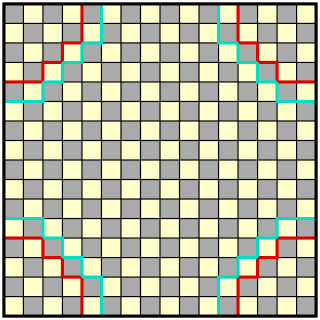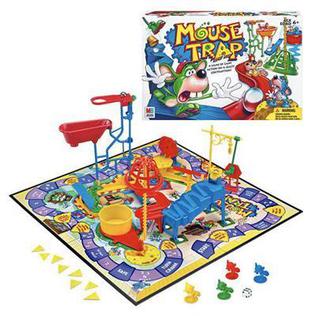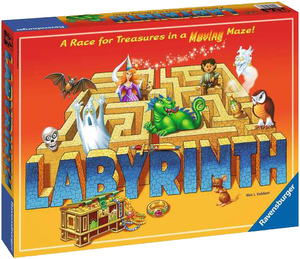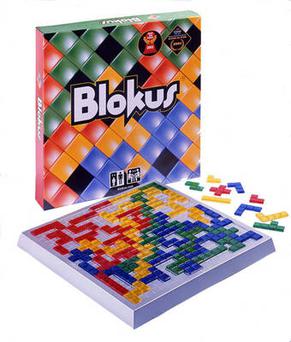
The Fantasy Trip (TFT) is a fantasy tabletop role-playing game designed by Steve Jackson and published in segments by Metagaming Concepts starting in 1977 and culminating in 1980. In 2019, Steve Jackson Games republished it as The Fantasy Trip Legacy Edition.

Halma is a strategy board game invented in 1883 or 1884 by George Howard Monks, an American thoracic surgeon at Harvard Medical School. His inspiration was the English game Hoppity which was devised in 1854.

Talisman: The Magical Quest Game is a fantasy-themed adventure board game for two to six players, originally designed and produced by Games Workshop. The game was first released in 1983 and has gone through three revisions. As of 2021, the fourth edition (2008) is the latest version. The board game sold over 800,000 units by 2000.
Capablanca chess is a chess variant invented in the 1920s by World Chess Champion José Raúl Capablanca. It incorporates two new pieces and is played on a 10×8 board. Capablanca believed that chess would be played out in a few decades. This threat of "draw death" for chess was his main motivation for creating a more complex version of the game.

HeroQuest, is an adventure board game created by Milton Bradley in conjunction with the British company Games Workshop in 1989, and re-released in 2021. The game is loosely based around archetypes of fantasy role-playing games: the game itself was actually a game system, allowing the gamemaster to create dungeons of their own design using the provided game board, tiles, furnishings and figures. The game manual describes Morcar/Zargon as a former apprentice of Mentor, and the parchment text is read aloud from Mentor's perspective. Several expansions have been released, each adding new tiles, traps, artifacts, and monsters to the core system.

Mouse Trap is a board game first published by Ideal in 1963 for two to four players. It is one of the first mass-produced three-dimensional board games. Players at first cooperate to build a working mouse trap in the style of a Rube Goldberg machine. Then, players turn against each other to trap opponents' mouse-shaped game pieces.

Odyssey: The Compleat Apventure was a video game written by Robert Clardy and released by Synergistic Software in 1980. It was created for the Apple II platform and is considered one of the first microcomputer-based role-playing video games. The title was intentionally misspelled; Apventure is a reference to the Apple computer while "Compleat" is simply an Archaic spelling of the word "complete" meant to match the feel and setting of the game.

Archon II: Adept is a 1984 strategy/action video game developed by Free Fall Associates' Jon Freeman, Paul Reiche III and Anne Westfall, and published by Electronic Arts for various platforms. It takes place on a game board, except that when a piece lands on another player's piece, both are moved to a battle arena where they duel to the death. It is the sequel to the 1983 Archon: The Light and the Dark, which had a chess motif.

Labyrinth is a board game for two to four players, published by Ravensburger in 1986.

Blokus is an abstract strategy board game for two to four players, where players try to score points by occupying most of the board with pieces of their colour. The board is a square regular grid and the pieces are polyominoes. It was designed by French mathematician Bernard Tavitian and first released in 2000 by Sekkoïa, a French company. It has won several awards, including the Mensa Select award and the 2004 Teacher's Choice Award. In 2009, the game was sold to Mattel.
Wiz-War is a 4-player board game created by Tom Jolly and first published in 1985 through Jolly’s company, Jolly Games. It is described as a "beer and pretzels game".

Wyvern is an out-of-print collectible card game featuring dragons and wyverns battling for treasure. The game was produced by U.S. Games Systems, with the first, "Premiere Limited", card set launched in January 1995. In 1997, the "Kingdom Unlimited" edition was released, featuring 277 cards, and marking the end of production.

Enochian chess is a four-player chess variant, similar to chaturaji, associated with the Hermetic Order of the Golden Dawn. The name comes from the Enochian system of magic of Dr. John Dee, which was later adapted by Victorian members of the Golden Dawn into "a complete system of training and initiation".

Dungeonquest is a fantasy adventure board game originally published in Sweden in 1985 by Alga AB as Drakborgen, and subsequently published in English by Games Workshop in 1987.

Dungeon! is an adventure board game designed by David R. Megarry and first released by TSR, Inc. in 1975. Additional contributions through multiple editions were made by Gary Gygax, Steve Winter, Jeff Grubb, Chris Dupuis and Michael Gray. Dungeon! simulates some aspects of the Dungeons & Dragons (D&D) role-playing game, which was released in 1974, although Megarry had a prototype of Dungeon! ready as early as 1972.
Stratego: Legends is a strategy board game created and released by Avalon Hill in 1999. Set in a mythical world called "The Shattered Lands", the game pits the forces of good against the forces of evil. Gameplay and rules are similar to the original Stratego game, and also somewhat similar to chess. The game was discontinued by Avalon Hill in 2004.

RoboRally is a board game for 2–8 players designed by Richard Garfield and published by Wizards of the Coast (WotC) in 1994. Various expansions and revisions have been published by both WotC and by Avalon Hill.

Mystery Mansion is the name of a series of board games in which players search furniture and other objects inside a mansion to locate a hidden treasure or stash of money.

The Dungeons & Dragons Computer Labyrinth Game is an electronic board game released by Mattel in 1980.
















